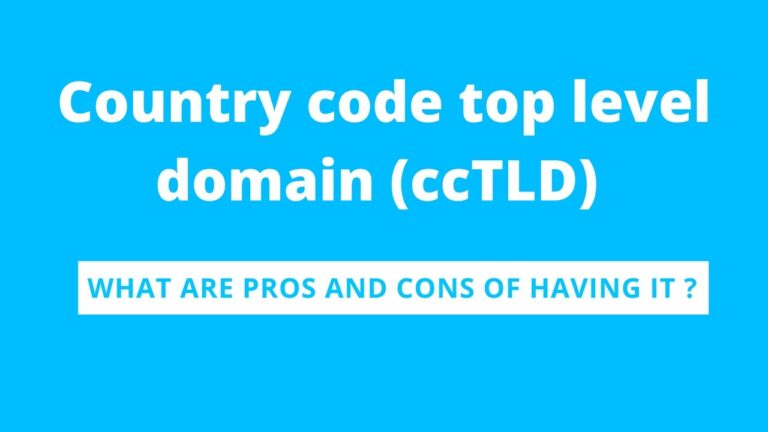This article provides a comprehensive guide on how to register a domain name for your blog. With the rise of online content creation, having a unique domain name has become not only a necessity but a crucial step towards establishing your brand and identity in the vast digital landscape. By following the step-by-step instructions outlined in this article, you will gain the knowledge and confidence to successfully register a domain name that reflects your blog’s purpose and appeals to your target audience. Secure your online presence and set the stage for a successful blogging journey by understanding the process of domain registration and making informed decisions along the way.
Registering a Domain Name
When it comes to registering a domain name, there are several important considerations to keep in mind. From choosing a domain registrar to understanding domain name privacy, each step plays a crucial role in ensuring the success and security of your online presence.
Choosing a Domain Registrar
Before registering your domain name, you will need to choose a domain registrar. A domain registrar is a company or organization that manages the reservation of domain names on the internet. It is important to select a reputable and reliable registrar to ensure the smooth and efficient management of your domain. Look for registrars that offer competitive pricing, excellent customer support, and a user-friendly interface.
Checking Domain Name Availability
Once you have chosen a domain registrar, the next step is to check the availability of your desired domain name. A domain name availability search allows you to determine whether the domain name you have in mind is already registered by someone else. It is essential to find a unique domain name that reflects the identity and purpose of your blog. If your desired domain name is not available, consider alternative variations or extensions.
Selecting the Right Domain Extension
Domain extensions, also known as top-level domains (TLDs), are the suffixes that appear at the end of a domain name (e.g., .com, .org, .net). Selecting the right domain extension is crucial as it affects how your website is perceived and ranked by search engines. .com is the most popular and widely recognized domain extension, while others like .org, .net, and country-specific extensions (e.g., .uk, .ca) may be more suitable for specific purposes. Consider your target audience and the nature of your blog when choosing a domain extension.
Understanding Domain Name Privacy
Domain name privacy refers to the protection of your personal information associated with your registered domain. When you register a domain, your name, address, phone number, and email address are collected and stored in a publicly accessible database called the WHOIS database. To ensure your privacy and protect against spam or identity theft, domain registrars offer domain privacy services that replace your personal details with the registrar’s own contact information. Investing in domain privacy can provide peace of mind and added security.
Domain Name Search
Before finalizing your domain name registration, it is essential to thoroughly research and consider various aspects of your domain name. This involves brainstorming ideas, utilizing domain name generators, checking for social media availability, and ensuring brand consistency.
Brainstorming Domain Name Ideas
Start the domain name search process by brainstorming a range of ideas that align with your blog’s niche and purpose. Consider keywords, relevant terms, and phrases that effectively convey the essence of your content and attract your target audience. Jot down as many ideas as possible to provide a pool of options to choose from.
Using Domain Name Generators
If you find yourself struggling to come up with a unique and appealing domain name, consider using domain name generators. These tools generate numerous name suggestions based on the keywords or terms you provide. They can help inspire your creativity, provide insights into available domain names, and offer alternatives that you may not have considered.
Checking Social Media Availability
In today’s interconnected digital landscape, it is crucial to have a consistent online presence across multiple platforms. Before settling on a domain name, check if the corresponding usernames or handles are available on social media platforms such as Facebook, Instagram, and Twitter. Consistency in branding and naming across these platforms can help enhance your online visibility and make it easier for users to find and engage with your blog.
Ensuring Brand Consistency
When choosing a domain name, it is essential to ensure brand consistency. Your domain name should align with your blog’s overall brand identity, including its tone, values, and target audience. Consider how your domain name fits into your branding strategy and how it can effectively represent your blog’s purpose and unique selling points. Aim for a domain name that is memorable, reflective of your brand, and resonates with your target audience.
Domain Name Registration Process
Once you have completed the research and decision-making process, it’s time to proceed with the domain name registration process. This involves creating an account, choosing a hosting provider, selecting the desired domain name, and configuring the domain name settings.
Creating an Account
To register a domain name, you will first need to create an account with your chosen domain registrar. This typically involves providing personal information, such as your name, email address, and contact details. Ensure that the registrar has a secure and user-friendly account creation process to safeguard your sensitive information.
Choosing a Hosting Provider
Alongside registering a domain name, it is important to consider choosing a hosting provider. A hosting provider is a company that stores your website’s files and makes them accessible on the internet. Look for a hosting provider that offers reliable server performance, adequate storage and bandwidth, excellent customer support, and value for money. Some domain registrars also offer hosting services, making it convenient to manage both your domain and hosting in one place.
Selecting the Desired Domain Name
Once your account is set up and you have chosen a hosting provider, proceed to select your desired domain name from the available options. Enter the chosen domain name in your registrar’s search function to confirm its availability. If the domain name is available, you can proceed with the registration process. If not, explore different variations or extensions until you find a suitable option.
Configuring Domain Name Settings
During the registration process, you will have the opportunity to configure various domain name settings. These settings include determining the domain’s nameservers, setting up email forwarding, and enabling domain forwarding. Consult your domain registrar’s documentation or support team for guidance on how to configure these settings to meet your specific needs.
Domain Name Pricing and Renewals
Before finalizing your domain registration, it is vital to understand the pricing structure associated with domain names. This includes evaluating the costs, comparing prices across different registrars, considering domain renewal fees, and securing long-term domain ownership.
Understanding Domain Name Costs
Domain name costs can vary depending on the registrar, domain extension, and any additional services or features included in the registration package. Some registrars may offer low initial prices but charge higher renewal fees. Understand the breakdown of costs, including domain registration, domain privacy, and any other add-ons, to ensure transparency and to make an informed decision.
Comparing Prices of Different Registrars
To ensure you are getting the best value for your money, it is essential to compare the prices of domain registration and related services across different registrars. Consider the reputation, customer reviews, and support offerings of each registrar when making your decision. Avoid choosing a registrar solely based on price, as the quality of service and customer support can significantly impact your domain management experience.
Considering Domain Renewal Fees
Domain renewal fees are the costs associated with renewing your domain registration after the initial registration period. Some registrars offer discounted prices for the first year but increase the renewal fees. Take this into account when choosing a registrar and consider the long-term costs of maintaining your domain name.
Securing Long-term Domain Ownership
To ensure your domain name remains under your control, it is advisable to secure long-term ownership. Consider registering your domain name for multiple years in advance to avoid the risk of losing it due to expiration or potential price increases. This can provide stability for your online presence and save you the hassle of frequent renewals.
Protecting Your Domain Name
Protecting your domain name is essential to maintain the integrity and security of your online brand. Implementing measures such as domain name locking, two-factor authentication, strong passwords, and up-to-date contact information can help safeguard your domain against unauthorized access and potential cyber threats.
Using Domain Name Locking
Domain name locking, also known as domain lock or transfer lock, is a security feature that prevents unauthorized transfers or modifications to your domain name settings. When enabled, domain name locking adds an extra layer of protection and ensures that your domain remains secure and under your control.
Enabling Two-Factor Authentication
Two-factor authentication (2FA) provides an additional level of security by requiring users to provide two different forms of identification to access their domain management account. This typically involves a password and a unique, time-sensitive code sent to a mobile device or email address. Enabling 2FA can significantly reduce the risk of unauthorized access and protect your domain from potential hackers.
Setting Strong Passwords
Creating strong and unique passwords is crucial for protecting your domain name. Avoid using common or easily guessable passwords and opt for a combination of uppercase and lowercase letters, numbers, and special characters. Regularly update your password and avoid reusing passwords across different accounts to prevent potential security breaches.
Keeping Contact Information Up-to-Date
Maintaining accurate and up-to-date contact information associated with your domain is vital. This information is crucial for receiving important notifications and managing your domain effectively. Regularly review and update your email address, phone number, and other contact details to ensure that you receive important domain-related correspondence.
Domain Name Transfer
In certain situations, you may need to transfer your domain name to a different registrar or account. Whether you are changing registrars or transferring ownership, understanding the domain name transfer process is essential to ensure a smooth and successful transition.
Unlocking Your Domain Name
Before initiating a domain name transfer, you will typically need to unlock your domain. Domain locking, which enhances security, may prevent transfers, so you must disable this feature before proceeding with the transfer process. Review your registrar’s documentation or contact their support team for guidance on how to unlock your domain.
Requesting an Authorization Code
To initiate a domain name transfer, you will need to obtain an authorization code, also known as an EPP code or transfer key, from your current registrar. This code verifies that you have permission to transfer the domain. Contact your registrar and request the authorization code, following any instructions they provide.
Initiating the Domain Name Transfer
Once you have obtained the authorization code, you can initiate the domain name transfer process with your new registrar. This typically involves providing the authorization code, initiating the transfer request, and paying any applicable transfer fees. The specific steps may vary depending on the registrars involved, so carefully follow the instructions provided by your new registrar.
Confirming the Domain Transfer
After initiating the domain transfer, it is important to confirm the transfer to ensure its completion. This may involve responding to email notifications, providing additional verification, or confirming the transfer through your new registrar’s account portal. Regularly check the status of the transfer and follow any additional steps provided by the registrars involved to ensure a successful transfer.
Domain Name Management
Once your domain name is registered and successfully transferred, effective domain name management is crucial to maintain its functionality and ensure optimal performance. This includes renewing your domain, updating DNS settings, managing subdomains, and transferring domain ownership if necessary.
Renewing Your Domain Name
Domain name registration is typically valid for a specific period, after which you will need to renew the registration to retain ownership of the domain. Set reminders to renew your domain before it expires to avoid any disruptions to your website. Many domain registrars offer an auto-renewal feature, which automatically renews your domain registration unless you manually disable it.
Updating DNS Settings
Domain Name System (DNS) settings determine how your domain name is connected to your website and various online services. Configuring DNS settings correctly is essential for your website to function correctly. These settings involve mapping your domain to your hosting provider’s server and configuring other records such as email, subdomains, and redirects. Consult your domain registrar’s documentation or support team for guidance on how to update your DNS settings.
Managing Subdomains
Subdomains are extensions of your primary domain that can be used to create separate sections of your website or host additional web applications. For example, a blog can have a subdomain such as “blog.yourdomain.com.” Managing subdomains involves creating, configuring, and maintaining these separate sections within your domain. Consult your hosting provider’s documentation or support team for instructions on managing subdomains.
Transferring Domain Ownership
In certain circumstances, you may need to transfer domain ownership to another individual or organization. This may be necessary if you sell your website or transfer it to a different entity. To transfer domain ownership, follow the specific procedures outlined by your domain registrar and ensure that both parties involved in the transfer understand and agree to the terms.
Domain Name SEO Considerations
Choosing the right domain name can significantly impact your website’s search engine optimization (SEO) efforts. While the domain name itself is just one factor among many that affect SEO, considering certain aspects can help improve your website’s visibility, ranking, and overall online presence.
Choosing a Keyword-rich Domain Name
Including relevant keywords in your domain name can help improve your website’s visibility in search engine results. Consider incorporating keywords that align with your blog’s niche, content, or target audience. However, striking a balance is important, as keyword stuffing or using excessive keywords in your domain name may negatively impact your SEO efforts.
Avoiding Hyphens and Numbers
While hyphens and numbers can be used in domain names, they may make it less memorable and harder to share verbally. Additionally, they can sometimes be associated with lower-quality websites or spammy practices. Aim for a domain name that is easy to pronounce, spell, and remember, which in turn can enhance your website’s SEO potential.
Including Local or Relevant Keywords
If your blog targets a specific geographical location or serves a particular niche, incorporating local or relevant keywords in your domain name can help attract your target audience. This can improve your website’s visibility in localized search results, allowing you to target specific markets or demographics effectively.
Keeping the Domain Name Short and Memorable
Short and memorable domain names are not only easier for users to remember and type, but they can also make your website more shareable and brandable. Strive for simplicity and clarity in your domain name to enhance user experience and potentially increase your website’s traffic, engagement, and SEO performance.
Legal Considerations for Domain Names
When registering a domain name, it is important to consider the legal aspects and potential risks associated with it. Understanding trademark infringement, checking copyright restrictions, avoiding illegal or offensive names, and having a plan for resolving domain name disputes can help protect your online brand and mitigate any legal issues that may arise.
Understanding Trademark Infringement
Trademark infringement occurs when a domain name, or any other brand identifier, infringes upon the trademark rights of another party. It is essential to conduct thorough research and ensure that your chosen domain name does not infringe upon any existing trademarks. Familiarize yourself with trademark laws and regulations in your jurisdiction to avoid potential legal complications.
Checking Copyright Restrictions
Similar to trademark infringement, copyright infringement can occur if your domain name infringes upon someone else’s copyrighted material. Use original content and avoid using copyrighted names, phrases, or designs in your domain name to prevent potential legal issues. Seek legal advice if you are uncertain about the copyright status of your domain name.
Avoiding Illegal or Offensive Names
When registering a domain name, it is essential to avoid names that are illegal or offensive. This includes names that promote hate speech, discrimination, or illegal activities. Not only can such names damage your reputation and hinder your online success, but they can also violate applicable laws and regulations. Comply with local, regional, and international laws and regulations governing domain name registration and content.
Resolving Domain Name Disputes
In the event of a domain name dispute, having a plan in place to resolve the issue can help protect your online brand and minimize potential legal consequences. Different dispute resolution mechanisms, such as negotiation, mediation, arbitration, or even legal action, may be available depending on the jurisdiction and the nature of the dispute. Familiarize yourself with the dispute resolution procedures provided by your domain registrar and consult legal professionals if necessary.
Registering a domain name for your blog involves several important considerations. From choosing the right domain registrar to understanding the legal implications, each step plays a crucial role in the success and security of your online presence. By carefully considering domain availability, pricing, privacy, and protection measures, you can ensure that your domain name reflects your blog’s identity, resonates with your target audience, and secures a prominent position in the online world.




